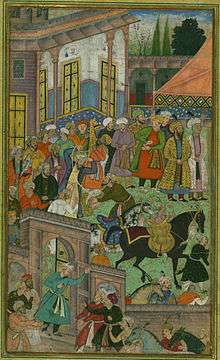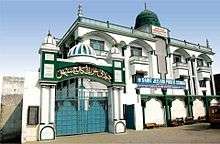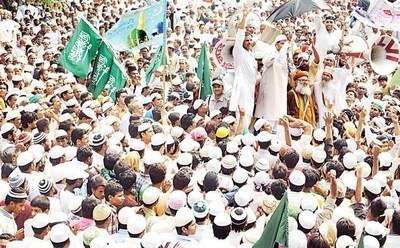Sambhal
| Sambhal سمبھل संभल | |
|---|---|
| City | |
 Sambhal Location in Uttar Pradesh,North India | |
| Coordinates: 28°35′N 78°33′E / 28.58°N 78.55°ECoordinates: 28°35′N 78°33′E / 28.58°N 78.55°E | |
| Country |
|
| State | Uttar Pradesh |
| Founded by | Prithviraj Chauhan |
| Government | |
| • Type | Municipality |
| Area | |
| • Total | 16 km2 (6 sq mi) |
| Elevation | 293 m (961 ft) |
| Population (2014)[1] | |
| • Total | 220,813 (city only) |
| • Density | 11,433/km2 (29,610/sq mi) |
| Demonym(s) | Sambhali |
| Time zone | IST (UTC+5:30) |
| PIN | 244302 |
| Telephone code | (+91) (05923) |
| Vehicle registration | UP 38 Old registration = UP 21 (Till 2011) |
| Website |
sambhal |
Sambhal (Hindi: संभल, Urdu: سنبھل) is a city in Uttar Pradesh, India. Sambhal is a Muslim dominated area.[2] It takes 2 hours 40 mins to reach Sambhal and is 158.6 kilometres (98.5 mi) from New Delhi.[3]
Sambhal district, which had population of around 22 lakh, was carved out of Moradabad district in September 2011. It consists of three tehsils — Sambhal and Chandausi, taken from Moradabad, and Gunnaur, taken from Badaun. Sambhal city is famous for its unique kind of horn and bone craft items which is manufactured in Sarai Tarin 4 km away from Sambhal city (but included in Sambhal) which are being exported. Sambhal headquarter is situated in Pawasa Sambhal.[4]
History

Sambhal has a rich history and has been home to several rulers and emperors. It was found in Satyuga. At that time it was a very big city. From the Lodi’s to the Mughal’s, right from the 5th century BC and spanning up to the 16th Century, it has been under the rule of one emperor or the other.
During 5th century BC, Sambhal was home to the Panchal rulers and was subsequently a part of king Ashoka’s empire.
During the 12th century, Prithviraj Chauhan, Delhi’s last Hindu ruler is said to have engaged in two fierce battles here which were both fought against Ghazi Sayyad Salar Masud, who was the nephew of the ruler of the Ghazni empireMahmud Ghazni. Chauhan gained victory over the latter in the first war and vice versa is said to have occurred in the second war. There nevertheless is no circumstantial evidence to prove the same and is widely regarded as a legend.
Qutubuddin Aibak, the first Muslim sultan of Delhi, seized Sambhal and included it under his empire. That was in the early 14th Century and subsequently, Firoz Shah Tughlaq, another sultan of Delhi, raided the town of Sambhal as one of the Hindu rulers from there was responsible for the killing of several of his men. He, therefore, administered a Muslim rule in Sambhal to try and vanquish all of the Hindu ruler’s forces and enslave him for the rest of his life.
In 15th century BC, Sikandar Lodi, the second ruler of the Lodi empire, declared Sambhal as one of the capitals of his vast empire and it remained that way for four long years.
After the previously mentioned empires had collapsed, it was then the turn of the Mughals to stake a claim in the offerings of Sambhal as a place that was most suited to be the capital of their empire. Babar, the first Mughal ruler constructed the first Babri Masjid in Sambhal which is to date considered to be a historic monument. He later on made his son Humayun the governor of Sambhal and Humayun in turn passed on the reigns to his son Akbar. Sambhal is said to have flourished under the Akbar rule but subsequently deteriorated in popularity when Akbar’s son Shah Jahan was made the incharge of the city. [5][6]
Tourism and attractions

- Shahi Jama Masjid The Sambhal mosque, built by a Mughal general, Mir Hindu Beg, in 1528, is the only surviving Mughal building constructed during the time of Babar. This is the famous Jama-Masjid (mosque) located in the Kot East colony of Sambhal. It is also the biggest mosque in sambhal.[7]
- Chakki Ka Paat Chakki Ka Paat refers to the traditional stone grinder. It was used in the older days to grind the food. These traditionally grinders are generally very heavy as they are made of stone and it takes a lot of effort to use them. But one man from Sambhal, popularly known as Nut is said to put it on the height of 50 feet and hung it on top by making some stunts. Today the grind is in same condition and the people can have a look themselves to believe it.
- Tota maina kabr is a famous tourist spot and enshrouded in mystery. It is an unoccupied tomb that has calligraphy present on it and is popularly known as the Tota Maina Kabr. Many historians have failed to know of its real origins and who was responsible for it.
- Kalki Mandir This is a Hindu temple of Shri Kalki Bhagwan at city of Sambhal. It is believed that Shri Kalki Bhagwan shall born here in this city to remove devils from this Earth when Kalyug shall be at its peak.
- Suraj Kund Mandir This temple is famous of having a kund in the compound and have a temple of Surya around that kund. Temple compound is huge and composers many Hindu idols inside it. Temple also have a once in a year festival called Surajkund ki Feri, organized every year after diwali.
- Manokamna Mandir This temple is again having a huge compound and is famous for fulfilling the wishes of the believers who come here for the prayers.
- Gauri Shaya Mandir Situated in Kot East area near Kumar Nursing Home, this temple is not very old as compared to temples of Surajkund and Manokamna, but has been maintained very well and have very nice attractive Hindu idols.
- Chemnath Teerth This temple is situated on Moradabad road and has a samadhi of Chemnath baba, its main visited on a Thursday where people come for wishes and pay tribute to baba in form of a cotton sheet.
- Singhpur Teerth This is a newly build temple after a Shiv Ling was found during a construction in a village. It suddenly got popularity and is now a famous Shiva temple, also it has a very nice pond inside the temple premises.
There are other popular temples as well like Punjabi Mandir, Bankhandan ka Mandir, Raisatti ka Mandir, Sai baba mandir, Chawhatteshwar Mandir,Maskan-E-Yaqub etc.
Sambhal is believed to have 68 theerths, 36 pura's, 52 sarai.
Sufis and shrines
Sambhal is well known to have a large number of Shrines of Sufi Saints, for its history goes back to Sultanate period. From the earlier there became a number of Sufi Saints belonging to various Sufi orders like Qadriya, Chishtiya, Ashrafiya and Warsia etc.
- Shaikh Taju'd-Din (d. 1642 AD), a respected Islmaic Scholar and Sufi, belonged to Sambhal and had made contact with Khwaja Baqi Bi'llah to search a spiritual guide and left Sambhal soon to settle in Delhi. Then after he moved to his native city to teach his disciples and brought them to Naqshbandiya Sufi order.[8]
Climate
Sambhal features an atypical version of the humid subtropical climate. The warm season lasts from 9 April to 8 August with an average daily high temperature above 36 °C (97 °F). The hottest day of the year is 22 May, with an average high of 38 °C (100 °F) and low of 25 °C (77 °F).[59] The cold season lasts from 11 December to 11 February with an average daily high temperature below 18 °C (64 °F). The coldest day of the year is 4 January, with an average low of 2 °C (36 °F) and high of 15 °C (59 °F).[59] In early March, the wind direction changes from north-westerly to south-westerly. From March to May the weather is hot.[60] The monsoon arrives at the end of June, along with an increase in humidity.[60] The brief, mild winter starts in late November, peaks in January and heavy fog often occurs.[61]
Temperatures in Sambhal usually range from 5 to 40 °C (41.0 to 104.0 °F), with the lowest and highest temperatures ever recorded being -1.0 and 47.8 °C (30.2 and 118.0 °F) respectively.[62] The annual mean temperature is 25 °C (77 °F); monthly mean temperatures range from 13 to 32 °C (55 to 90 °F). The highest temperature recorded in July was 45 °C (113 °F) in 1931.[63][64] The average annual rainfall is approximately 714 mm (28.1 in), most of which falls during the monsoon in July and August.[7] The average date of the advent of monsoon winds in Sambhal is 29 June.[65]
Demographics
As per provisional reports of Census India 2011, the population of Sambhal city in 2011 is 221,334; of which male and female are 116,008 and 105,326 respectively. Total literates in Sambhal city are 92,608 of which 51,382 are males while 41,226 are females. Average literacy rate of Sambhal city is 49.51 percent of which male and female literacy was 52.27 and 46.45 percent. The sex ratio of Sambhal city is 908 per 1000 males and child sex ratio of girls is 936 per 1000 boys. Total children (0-6) in Sambhal city are 34,279 as per the records of Census India report on 2011. There were 17,702 boys while 16,577 are girls. The child forms 15.49% of total population of Sambhal City.
Trade
Major trades in Sambhal city are Menthol produce and its side products. In its sub city Sarai-tareen handicrafts of horns are being made and exported to various countries. Apart from this Sambhal is majorly dependent on the agriculture produce hence a little production of agricultural equipments is also done on a small scale. Sambhal is also known for its bricks production trade with having a large number of factories around.
Transportation
Rail
Sambhal is only connected with one major city of Uttar Pradesh and that is Moradabad.
Road

Sambhal is well-connected to Delhi, Moradabad, Lucknow, Noida and other cities like Aligarh, Khair, Badaun, Amroha, etc. NH-24, SH-51 are some of the roadways connecting all major cities to Sambhal.
Education
Higher and professional education
Institutions imparting a great deal of higher education in Sambhal are mainly government degree colleges. These include:
- Mahatma Gandhi Memorial (Post-Graduate) College
- Government PG College (राजकीय महाविद्यालय सम्भल)
- Azad Girls Degree College
- Grandmark Institute of Technology & Management (Sambhal)
- Shree K.S. Degree College, Asmoli, Sambhal
Recently, Maulana Azad National Urdu University, a Central University by the Act of Parliament of India,[10] established its sub-regional centre in Sambhal. The centre is housed in Al-Tareen ITI Campus,[11] Sambhal. The MANUU centre in sambhal is providing education in professional and semi-professional disciplines.
Another distance learning center of Centre for Distance Education, Aligarh Muslim University is situated at Madrasa Sirajul Uloom Hilali Sarai Sambhal[12] providing education in courses like B.A.(Honors), B.Com (Honors) etc.
Secondary education
Secondary education (Pre-University) is well flourished in Sambhal. A host of institutions provide a great deal of variety in education with factors like diversity in medium of pedagogy, affiliation to different education board, financial affordability, distance etc. Given below is detailed account of schools based on their affiliation with educational boards:
State Board Institutions



These institutions constitute a class of schools or intermediate (pre-university) colleges that are governed by mandates and under guidance of apex education body of state government i.e. Uttar Pradesh Madhyamik Shiksha Parishad. Latter is commonly known as UP Board. The institutions in this category are:
- Al-Qadeer Higher Secondary School, Sambhal
- Hind Inter College, Sambhal
- S.B.S.J. Inter College
- Chandravati Inter College, Adholi Mafi
- T.H Inter College, Mehmood khan sarai
- Arya Samaj Inter College
- Faiz Girls Inter College
- B. D.Inter College
- Z.U. Inter College
- Government Girls Inter College (राजकीय कन्या इण्टर कॉलेज)
- A.M.H.R.S. Inter College
- Chandawali Inter College, Singhpur Sani
- Radha Krishna Inter College, Dhansoli
- Nighat Public School, Hayat Nagar
- Chandawali Inter College, Singhpur
- Zam Zam Educational Academy
- St. Waris Public School
- Lakhori Inter College - Lakhori, Sambhal
Above institutions impart education in Hindi or Urdu medium.
Madrasa Board Institutions
These institutions are affiliated to U.P Board of Madrasa Education.[13] Courses offered by these institutions are MUNSHI,MOLVI,ALIM,KAMIL etc, in different subjects. Certificates of offered courses are accepted by several universities around the nation. Students of Madrasa Board Courses are also eligible for several Govt. scholarship schemes. Some Madrasa Board's institutions are as follows:
- Madrasa Sirajul Uloom Hilali Sarai Sambhal[14]
- Madrasa Ziya-ul-uloom Sarai tareen Sambhal
Central Board Institutions
These institutions are affiliated to those boards (CBSE, ICSE) that fall under ambit of federal government of India. Most of these impart education in English medium.
- Mother Public School,Mian Sarai
- Blooming Buds Co. Ed. School,Joya Road
- Bal Vidya Mandir Sr. Sec. School
- O.P.L. Public School, Hyatnagar
- Saint Jeelani Public School
- Doon Modern School
- Sanatan Public School
- Saraswati Vidhya Mandir Sr. Secondary School
- St.Amtul Public School
- St Mary's Secondary School
- Mumtaz Modern Public School
- Horizon Public School, Sambhal
- St. Anthony's Senior Secondary School, Dugawar, Asmoli
- Allama Iqbal Modern Public School, Miyan Sarai,Sambhal
- Mission International Academy
Oriental and Theological Institutions
- Madarsa Ahle-Sunnat Qadeer-ul-Uloom Husainiya Ashrafiya, Mandi Kishan Das Sarai[15]
- Markazi Madarsa Ahle Sunnat Ajmal al-Uloom, Mentha Mandi Arya Samaj Road, Sambhal
- Madarsa Ahle Sunnat Faizul Uloom, Saraitarin
- Madarsa Ahle Sunnat Khaleel ul-Uloom, Raisatti Sambhal
- Madarsa Darul Uloom Husainiya, Delhi Road, Fateh Ullah Sarai
- Madrasa Siraj-ul-uloom, Hilali Sarai Sambhal[16]
Religious significance

Sambhal has been a point of attraction for primitive time. During the rule of Delhi sultanate the city was considered an integral part of reign. Today it is well populated area having Muslim majority in it. There is a number of religious movements which are being run by the different communities for the safeguard of their tradition and culture to make city more peaceful. All India Ulema and Mashaikh Board protested against the caricatures of the Muslim prophet Muhammad in the city.[17]
Festivals and culture
In spite of being a Muslim dominated area, the city is multicultural. There is the 70% majority of Muslims but all festivals are celebrated peacefully. On the occasion of Muharram, a large gathering of Muslims and other casts or religion make participation in Azadari whether they are sunni or shia and belong to other community.[18] The entire town comes ahead on this occasion of Muharram and emphasizes on maintaining the peace inside. Villages like Mandi Kishan Das Sarai, Kaghzi Sarai, Nooriyon Sarai and Saif Khan Sarai are considered as the integral parts to organize this occasion of Ashura. Moreover, the festivals like Eid, Eid Miladun Nabi, Neza, Holi, X-mas day and Diwali are celebrated with great enthusiasm every year by the locals.
Although Sambhal is said to be heavily populated by the Muslims, the city is also much influenced by other culture and significance. It’s a place where Hindus and Muslims co-exist peacefully. Many mosques are part of modern-day Sambhal with some even dating back to the 14th and 15th century.[19]
Eid Milad un Nabi
The occasion of the birth of Muhammad is celebrated in the city. The juloos starts from various theological institutions and schools and gathers around the domains of the city.
Media in Sambhal
- Dainik Jagran
- Amar Ujala
- Azizulhind urdu
- Inquilab Urdu
- Sahafat Urdu
- Awam-e-Hind
- Hindustan
- Gareeb Aur Nirdhan Ki Pukar (Hindi Weekly newspaper ).
- Shah Times
- Sahara Urdu
- Sahara Hindi
- Naye Samaj Ka Darpan
- Uttar Kesri
- Daghi Kaun
- Dainik Ugta Bharat
Notable people
See also
- Sambhal district
- Al-Qadeer Higher Secondary School, Sambhal
- All India Ulema and Mashaikh Board
- Sambhal (Assembly constituency)
- Madrasa Sirajul Uloom Hilali Sarai Sambhal
References
- ↑ "Census of India Search details". censusindia.gov.in. Retrieved 10 May 2015.
- ↑ http://articles.economictimes.indiatimes.com/2004-03-22/news/27375144_1_poll-fray-akhilesh-yadav-balram-singh-yadav
- ↑ http://www.distancesfrom.com/distance-from-New-Delhi-to-Sambhal/DistanceHistory/5148.aspx
- ↑ http://m.indianexpress.com/news/shift-district-hq-to-sambal-residents/1001978/
- ↑ http://www.britannica.com/EBchecked/topic/520415/Sambhal
- ↑ Ain-i-Akbari, Vol II, Tr.H.S. Jarrett, Atlantic Publishers and Distributors, New Delhi, repr., 1989. p. 295.
- ↑ https://foursquare.com/v/jama-masjd/4e5759472271d1a145808787
- ↑ KA Nizami, Some aspects of religion and politics in India during the thirteen century, Aligarh 1964.
- ↑ http://www.censusindia.gov.in/2011-prov-results/paper2-vol2/data_files/India2/Table_2_PR_Cities_1Lakh_and_Above.pdf
- ↑ http://www.manuu.ac.in/overview.php
- ↑ http://www.manuu.ac.in/sub-sambhal.php
- ↑ http://www.cdeamu.ac.in/centres.php
- ↑ http://upbme.edu.in/
- ↑ http://upbme.edu.in/
- ↑ http://www.alqadeer.in
- ↑ http://www.madrasasirajululoom.com
- ↑ http://www.thehindu.com/news/national/article2543620.ece
- ↑ http://www.sambhalonline.in/city-guide/about-sambhal
- ↑ http://www.dli.ernet.in:8080/dlix/bitstream/handle/2015/1860/Sambhal--A-Historical-Survey.pdf?sequence=1&isAllowed=y